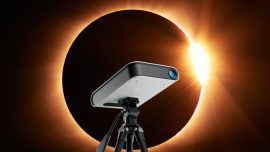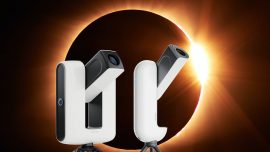Comet Tsuchinshan-ATLAS is set to light up the night sky in late september and october, offering a unique spectacle for amateur astronomers and stargazers alike. This celestial object is not just a beautiful sight but also a rare opportunity to observe a comet as it makes its journey around the sun. This guide will help you prepare and learn how to observe Comet Tsuchinshan-ATLAS and making the most of this cosmic event.
What is Comet Tsuchinshan-ATLAS?
Discovery of Comet Tsuchinshan-ATLAS
Comet Tsuchinshan-ATLAS (also referenced as C/2023 A3) was independently discovered by two observation projects: Tsuchinshan (also known as Purple Mountain Observatory of the Chinese Academy of Sciences) in January 2023 and ATLAS (Asteroid Terrestrial-impact Last Alert System), an automatic astronomical warning system in South Africa, in February 2023. This comet has captured the interest of the astronomical community because it is expected to be particularly bright as it approaches its perihelion in September 2024. The comet could be visible to then necked eye and could even rich negative magnitude according the most optimistic estimations. Though, predictions about comet’s behavior are always marked by some degree of uncertainty. One key risk is that the comet could fragment as it passes closest to the sun.
Comet Characteristics
Tsuchinshan-ATLAS has a distinct tail made of gas and dust. Like other comets, it consists of ice, rock, and organic compounds, offering scientists an opportunity to study the building blocks of the early solar system. Its brightness and proximity to Earth make it an ideal object for observation in the night sky, especially for amateur astronomers.
Source : Don Pettit – NASA
When will Comet Tsuchinshan-ATLAS be visible?
Key Dates
Comet Tsuchinshan-ATLAS is expected to reach its closest point to the sun, known as perihelion, on September 27, 2024 at 58 millions kilometers from the sun. It will then make its closest approach to Earth on October 12 (71 million kilometers). Leading up to this date, the comet will grow brighter. For those interested in observing the comet at its best, planning around late September and mid October will provide optimal conditions.
Best Viewing Conditions
- Starting From September 27, the comet will be visible from the northern hemisphere at dawn, just before the sunrise, on the eastern horizon.
- From October 3 to October 9 the comet won’t be observable as it will pass between the Sun and Earth.
It will become visible again starting from the 10 just after the sunset. It is expected to reach its maximum brightness between the 10 and the 14.
The comet should be observable with binoculars and probably with the naked eye. However, a very clear horizon is necessary.
Using a small telescope will significantly enhance the view, revealing more details such as its coma (the cloud surrounding the nucleus) and tail.
How to Observe Comet Tsuchinshan-ATLAS
When it comes to observing Comet Tsuchinshan-ATLAS, having the right tools and preparation can make all the difference. Drawing from Vaonis‘ expertise in comet observation, the following steps will help you get the best experience when observing this cosmic visitor.
Tools for observation
Whether you are a casual stargazer or an experienced astronomer, the right tools can enhance your observation experience. Vaonis’ Vespera II and Vespera Pro smart telescopes may allow the observation of the comet between September 27 and October 2. It will not be possible during the beginning of the second observation timeframe since our instruments can’t be initialized during daylight. The comet will quickly disappear below the horizon after twilight.
Hestia, Vaonis’ smartphone base telescope, could be an excellent choice to observe the comet during both observation windows.
During the second half of October, the comet will progressively reach a higher elevation in the sky and should be observable with our Vespera range.
For those who don’t have access to high-tech equipment, binoculars or a basic telescope will come in handy. Binoculars (with at least 7x or 10x magnification) offer a wider field of view, which is helpful for tracking the comet as it changes position in the sky.
Optimal Observation Techniques
To catch a clear view of Comet Tsuchinshan-ATLAS, you’ll need to start by finding its location in the sky. Unlike fixed objects like stars or galaxies, comets move across the sky, so keeping track of its coordinates is crucial.
If you intend trying observing it with Vespera, you’ll have to create a manual target based on the coordinates of the comet. Check out our blogpost on “How to catch a comet” here!
Choose an indirect (bright sky) pointing type. Watch our Video Tutorial on Singularity advanced features to learn how to create manual targets.
- Use Online Tools: Websites like The Sky Live provide up-to-date coordinates for comets. You’ll want to look for the comet’s “Right Ascension” and “Declination” (e.g., 14h 45m 22.4s, 67° 25? 05.9?). These values will guide you to the exact spot in the sky where the comet can be observed.
- Stellarium App: Another helpful tool is the Stellarium app, available for desktops and mobile devices. You can input your telescope’s data (such as focal length) to get a real-time preview of what the comet will look like through your equipment. This app also allows you to enter the comet’s name and display its current location in the night sky.
- Vaonis smart telescopes: If you’re using Vespera, you’ll need to create a manual target in Singularity app and enter the comet’s coordinates while comets are not part of the telescope’s pre-loaded database.
By using these digital tools, you can ensure that you’re always pointed in the right direction and capturing the best possible view of Comet Tsuchinshan-ATLAS.
Common Challenges When Observing Comets
Atmospheric Conditions
Cloud cover, humidity, and air turbulence can affect the quality of your observation. Check weather forecasts before heading out and try to observe on nights with clear skies and low humidity.
Equipment Issues
If you’re new to using a telescope or binoculars, it can take some time to get everything set up correctly. Make sure your equipment is properly calibrated and focused on the right coordinates. Practicing with your equipment ahead of time will save you from frustration on the night of the observation.
FAQs | how to observe Comet Tsuchinshan-ATLAS
- What is the best way to observe Comet Tsuchinshan-ATLAS?
The best way is to use a telescope or binoculars and refer to apps like Stellarium for precise coordinates.
- Can I see Comet Tsuchinshan-ATLAS without a telescope?
Yes, the comet will be visible to the naked eye particularly between October 10 and 14
- What time of night is best to see the comet?
Just before sunrise from September 27 to October 2. Just after sunset from October 10
- Will Comet Tsuchinshan-ATLAS be visible worldwide?
Yes. Thought It will be very low on the horizon at first.
- What apps can help track Comet Tsuchinshan-ATLAS?
Apps like Stellarium, The Sky Live, and SkySafari are excellent for tracking the comet in real time.
Comet Tsuchinshan-ATLAS offers a unique opportunity for both seasoned astronomers and casual stargazers to witness a cosmic event. By preparing with the right tools, apps, and techniques, you can ensure a memorable observation experience. Keep an eye on the sky as we approach September 2024, and don’t miss your chance to observe this dazzling comet.








